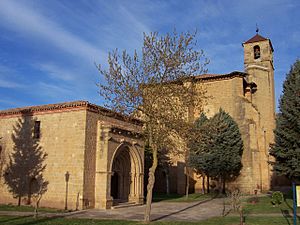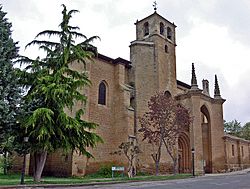Bañares facts for kids
Quick facts for kids
Bañares
|
||
|---|---|---|

Church and chapel in Bañares
|
||
|
||
| Country | ||
| Autonomous Community | ||
| Province | ||
| Comarca | Santo Domingo de la Calzada | |
| Area | ||
| • Total | 29.59 km2 (11.42 sq mi) | |
| Elevation
(AMSL)
|
595 m (1,952 ft) | |
| Population
(2018)
|
||
| • Total | 234 | |
| • Density | 7.908/km2 (20.48/sq mi) | |
| Demonym(s) | bañarense; la fajolo | |
| Time zone | UTC+1 (CET) | |
| • Summer (DST) | UTC+2 (CEST) | |
| Postal code |
26257
|
|
| Official language | Spanish | |
| Patron saint | Formerio | |
Bañares is a small town in La Rioja, Spain. It is a municipality located in the region of Santa Domingo de la Calzada. Bañares is about 45 kilometers (28 miles) west of Logroño, the capital city of La Rioja.
The main way people make a living in Bañares is through agriculture. They grow many crops like potatoes, cereals, beets, and green beans.
Contents
History of Bañares
The town of Bañares has a long history. It was first mentioned in records as early as 1051. This shows that the village existed almost a thousand years ago!
In 1133, King Alfonso the Battler gave some land in Bañares to a church leader. This was done by a special Royal Decree.
Later, in 1157, two battles happened near Bañares. These fights were between the armies of Sancho III of Castile and Sancho III of Navarre. They were fighting over land after the death of another king.
Around the year 1200, a brave hero named Pedro Fernández de Villegas I became the lord of Bañares. He was famous for his role in the Battle of Las Navas de Tolosa in 1212.
Bañares was often a place where battles took place in the 12th and 13th centuries. The kingdoms of Navarre and Castile frequently fought here.
In 1478, a special title, the Earl of Bañares, was given to Alvaro de Zúñiga y Guzmán. He owned the castle in Bañares. The town remained under his family's control until 1811.
Bañares used to be part of the Burgos province. But later, it became part of the Logroño province. Today, it belongs to the autonomous community of La Rioja.
The village has had a hospital since 1837, helping people with their health needs.
Population Over Time
As of January 1, 2010, Bañares had 321 people living there. This included 156 men and 165 women.
The chart below shows how the population of Bañares has changed over many years. You can see that the number of people living in the town has changed a lot since 1857.
| Vertical bar chart demographic of Bañares (municipality) between 1857 and 2010 |
|
EasyTimeline 1.90
|
| Population from 1857-1897.
Population from 1900-1991, and 2001. Population from 2010. |
What's in a Name?
The name "Bañares" comes from an old word meaning "baths." This suggests that there might have been Roman baths in the area a very long time ago. The Romans were known for building public baths.
Places to Visit
Bañares has some interesting old buildings and monuments that are worth seeing.
Historic Buildings
Chapel of Santa Cruz (Saint Mary the Ancient)
This chapel is a very old church built around the 12th century. It is an example of Romanesque architecture.
When a newer church was built, this older one was renamed Santa Maria la Antigua, meaning "Saint Mary the Ancient." It is considered an important cultural site.
Parish Church of the Holy Cross
This church is a Gothic building. Its construction started around 1490 and finished about 1510.
Inside the church, you can find the ark of San Formerio. This is a special chest that holds relics. It is a beautiful piece of Spanish Romanesque art from the 12th century. It is made of wood covered with colorful copper plates. This church is also a protected cultural site.
Bañares Castle Ruins
The old castle of Bañares is now mostly in ruins. Its stones were sold and used for other buildings.
We know it once had thick walls, a main tower (called a keep), and a moat for defense. Today, you can still see parts of its rectangular shape. It had round towers at the corners and by the entrance. The walls were very thick. The keep was inside, built with strong stone.
Festivals and Traditions
Bañares celebrates several fun festivals throughout the year.
St. Formerio Festival
The main festival honors St. Formerio, the patron saint of the village. It used to be celebrated at the end of September, after the harvest. Now, it's held on the third weekend of August.
These celebrations include religious events, the running of the bulls, rock concerts, and a big community meal. On September 25th, they still have a "Thanks" celebration.
Processions and Dances
Every day of the festival, there is a procession. Young people carry the statue of the patron saint and dance through the streets.
In the past, only boys would dance. They would even compete to be the dance team! Now, it's harder to find dancers, so women have also joined in.
The dancers wear white shirts and trousers with a red sash. They have colorful ribbons and a bright shawl on their shoulders. They wear white espadrilles with colored ribbons.
Some dances use castanets. These dances have two speeds: a slower one for most of the procession, and a very fast one just before entering the church.
Other dances use sticks and are called Troqueados. Two popular stick dances are the "dance of the Swords" and the "dance of the Professions." In the "dance of the Swords," dancers pretend to fight. In the "dance of the Professions," dancers act out different jobs like a tailor or a shoemaker.
Asking for Rebollo
Another unique tradition is called "Asking for Rebollo." This is a serenade for newlyweds when they return from their honeymoon. Friends and family gather outside the couple's house at night, singing songs. The newlyweds then treat everyone to liquor and pastries until the early morning.
Here are some of the songs they sing:
- It looks like I am watching you,
- going down the stairs
- with the bottle in my hand
- and cookies in the other.
- To these newlyweds
- we come to serenade them
- and to give them congratulations
- with all sincerity.
- To these newlyweds,
- we wish them good fortune
- and in about nine months
- may they have a child in the crib.
Delicious Local Food
The food in Bañares uses many fresh products from local gardens. You can enjoy dishes like vegetable stew (called Menestra Riojana), potatoes with sausage, and piquillo peppers.
The meat is also excellent. Try the local chorizo, sausages, and chuletillas al sarmiento (lamb chops cooked with vine shoots). The vine shoots come from the many vineyards in the area.
Sports and Recreation
Bañares has several places for sports and fun. There's a municipal pelota court, swimming pools, and soccer fields at La Salceda park.
You can also enjoy a tourist cycling route. It follows an old railroad track and is part of the "greenways" network, perfect for biking and walking.
See also
 In Spanish: Bañares para niños
In Spanish: Bañares para niños







